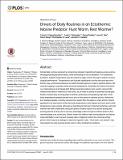Files in this item
Drivers of daily routines in an ectothermic marine predator : hunt warm, rest warmer?
Item metadata
| dc.contributor.author | Papastamatiou, Yannis P. | |
| dc.contributor.author | Watanabe, Yuuki Y. | |
| dc.contributor.author | Bradley, Darcy | |
| dc.contributor.author | Dee, Laura E. | |
| dc.contributor.author | Weng, Kevin | |
| dc.contributor.author | Lowe, Christopher G. | |
| dc.contributor.author | Caselle, Jennifer E. | |
| dc.date.accessioned | 2015-06-12T12:10:06Z | |
| dc.date.available | 2015-06-12T12:10:06Z | |
| dc.date.issued | 2015-06-10 | |
| dc.identifier | 194857463 | |
| dc.identifier | 1e72b571-1ed1-4809-9f4c-f81c684c50ea | |
| dc.identifier | 84936817473 | |
| dc.identifier | 000355979500058 | |
| dc.identifier.citation | Papastamatiou , Y P , Watanabe , Y Y , Bradley , D , Dee , L E , Weng , K , Lowe , C G & Caselle , J E 2015 , ' Drivers of daily routines in an ectothermic marine predator : hunt warm, rest warmer? ' , PLoS ONE , vol. 10 , no. 6 , e0127807 . https://doi.org/10.1371/journal.pone.0127807 | en |
| dc.identifier.issn | 1932-6203 | |
| dc.identifier.other | RIS: urn:7E1549052DFF2D6FB7BC6A18E876545B | |
| dc.identifier.uri | https://hdl.handle.net/10023/6819 | |
| dc.description | This work received funding from the MASTS pooling initiative (The Marine Alliance for Science and Technology for Scotland). MASTS is funded by the Scottish Funding Council (grant reference HR09011) and contributing institutions. Funding was also provided by a Grants-in-Aids for scientific research from the Japan Society for the Promotion of Science (25850138), the Hawai'i Undersea Research Laboratory/NOAA Coral Reef Conservation Program, the U.S. National Science Foundation GRFP, and the Marisla Foundation. | en |
| dc.description.abstract | Animal daily routines represent a compromise between maximizing foraging success and optimizing physiological performance, while minimizing the risk of predation. For ectothermic predators, ambient temperature may also influence daily routines through its effects on physiological performance. Temperatures can fluctuate significantly over the diel cycle and ectotherms may synchronize behaviour to match thermal regimes in order to optimize fitness. We used bio-logging to quantify activity and body temperature of blacktip reef sharks (Carcharhinus melanopterus) at a tropical atoll. Behavioural observations were used to concurrently measure bite rates in herbivorous reef fishes, as an index of activity for potential diurnal prey. Sharks showed early evening peaks in activity, particularly during ebbing high tides, while body temperatures peaked several hours prior to the period of maximal activity. Herbivores also displayed peaks in activity several hours earlier than the peaks in shark activity. Sharks appeared to be least active while their body temperatures were highest and most active while temperatures were cooling, although we hypothesize that due to thermal inertia they were still warmer than their smaller prey during this period. Sharks may be most active during early evening periods as they have a sensory advantage under low light conditions and/or a thermal advantage over cooler prey. Sharks swam into shallow water during daytime low tide periods potentially to warm up and increase rates of digestion before the nocturnal activity period, which may be a strategy to maximize ingestion rates. “Hunt warm, rest warmer” may help explain the early evening activity seen in other ectothermic predators. | |
| dc.format.extent | 3244843 | |
| dc.language.iso | eng | |
| dc.relation.ispartof | PLoS ONE | en |
| dc.subject | QH301 Biology | en |
| dc.subject | QL Zoology | en |
| dc.subject | SDG 14 - Life Below Water | en |
| dc.subject.lcc | QH301 | en |
| dc.subject.lcc | QL | en |
| dc.title | Drivers of daily routines in an ectothermic marine predator : hunt warm, rest warmer? | en |
| dc.type | Journal article | en |
| dc.contributor.institution | University of St Andrews. School of Biology | en |
| dc.identifier.doi | https://doi.org/10.1371/journal.pone.0127807 | |
| dc.description.status | Peer reviewed | en |
| dc.identifier.url | http://journals.plos.org/plosone/article?id=10.1371/journal.pone.0127807#sec012 | en |
This item appears in the following Collection(s)
Items in the St Andrews Research Repository are protected by copyright, with all rights reserved, unless otherwise indicated.

